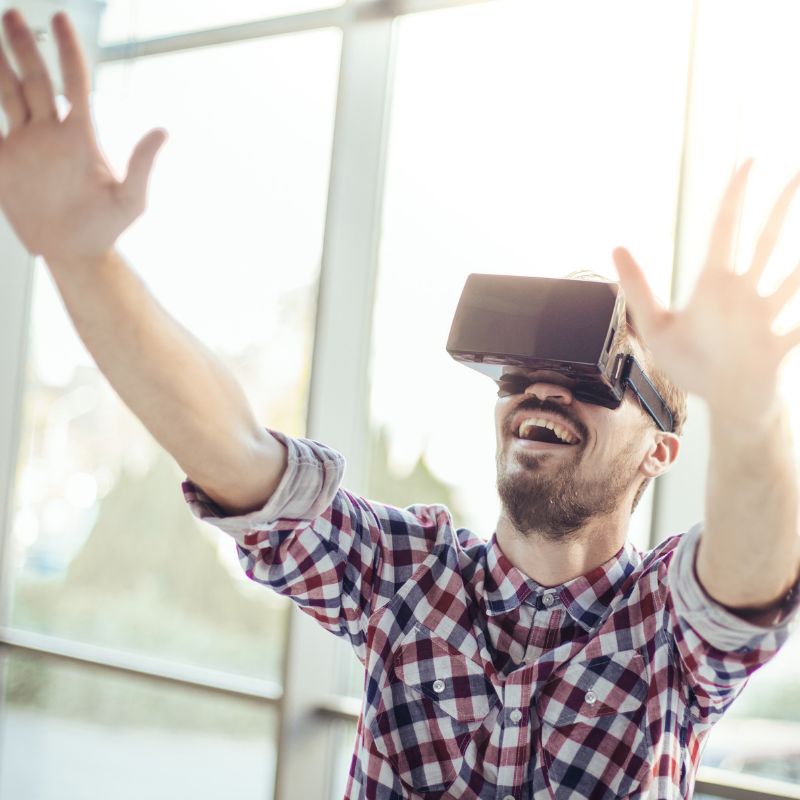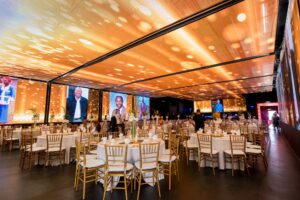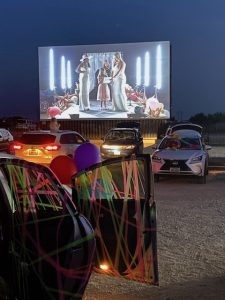Have you ever tried virtual reality gaming as an attraction at an event? This innovative technology can transport your guests to extraordinary worlds and interactive games without leaving the venue. Virtual reality is a great option for events, since it can cater to a wide range of interests and age groups, making it a versatile option for event planners looking to add a unique twist to any party, wedding, or corporate event.
In this blog, we’ll dive into five exciting ways you can use virtual reality for events!
- What is Virtual Reality (VR) Gaming
- Virtual Reality for Corporate Events: Is it a Good Idea?
- 5 Ways to Use Virtual Reality for Corporate Events
What is Virtual Reality (VR) Gaming?
Virtual Reality (VR) Gaming involves using special electronic equipment, like a headset and sometimes hand controllers, to play video games. A Virtual Reality (VR) headset is a key component of VR technology. It’s a head-mounted device that users wear over their eyes like a pair of goggles. Inside the headset, there are small screens in front of each eye that display images from a VR game or application. These screens are designed to cover your field of vision, immersing you fully in a virtual environment.
The headset also includes sensors that track your head movements. As you turn your head, the images on the screens adjust in real-time, making it feel like you’re actually looking around inside the virtual world. This tracking is what makes VR feel incredibly lifelike and interactive.
Virtual Reality for Events: Is it a Good Idea?
Absolutely, virtual reality is a great choice for events! This kind of attraction can fit any theme and adds a modern touch that can impress guests. Virtual reality is inherently interactive, unlike passive forms of entertainment like watching a video. It also allows you to select different environments that are tailored to the theme of the event! And an attraction like virtual reality immediately sets your event apart, which means you can use it as an edge in marketing for a corporate event or rest assured knowing your party guests will be talking about your event for years to come.
However, while VR is great for making your event stand out, there are some risks to consider. First, VR requires space and equipment, so you’ll need to plan your venue layout carefully to avoid accidents. Some people might also feel dizzy or nauseous after using VR, which is something to keep in mind when planning how long each session should last.
5 Ways to Use Virtual Reality for Corporate Events
If you’re planning a corporate event, virtual reality is a great way to add a unique twist that employees and prospects alike will enjoy. Virtual reality is a fantastic way to get your guests to break the ice with one another and spark conversations.
1. Demo Products at Your Event
Using virtual reality (VR) at events can deeply immerse prospective buyers in a product, significantly boosting their engagement. This immersive experience can increase the chances of a purchase by up to 135%. But why?
Using virtual reality (VR) at events offers a unique opportunity to engage prospective buyers in a way that traditional presentations and demos cannot match. By wearing a VR headset, attendees can interact with a product in a fully immersive environment, which allows them to experience the product’s features and benefits firsthand. This deep level of interaction helps create a memorable impression that can significantly influence purchasing decisions.
For example, consider Merrell’s use of Oculus Rift VR technology. They created a virtual hike that mimicked hiking on challenging mountain terrain, complete with motion capture technology to enhance the realism. The video below showcases the power of this experience and its effectiveness as a marketing tool, demonstrating just how impactful VR can be for brand promotion.
2. Event Marketing
Attending conferences can be a significant investment, and potential attendees often look for compelling reasons to justify the expense. To address this, many event planners are turning to virtual reality (VR) as an innovative tool to boost ticket sales and draw in crowds. VR technology offers a unique preview experience that traditional brochures or videos can’t match.
3. Virtual Attendance
What could be more convenient than attending global events from the comfort of your own home? Virtual reality (VR) makes this possible, eliminating the need for travel and allowing you to experience events worldwide without the associated time and cost. For attendees, this means unprecedented access to conferences, workshops, and seminars that might have been out of reach due to logistical or financial constraints.
In the virtual space, attendees can move around as if they were at a physical event. They can attend keynote speeches, participate in sessions, visit booths, and network with other attendees. Advanced VR setups allow for interactions such as handshakes, exchanging business cards, or even collaborative activities like workshops. Events can feature a mix of live and pre-recorded content. Live sessions are streamed in real-time within the VR environment, while pre-recorded content can be accessed on-demand by attendees at their convenience.
Many VR event platforms integrate with other technologies, such as mobile apps or traditional web interfaces, allowing participants who do not have VR headsets to still take part in some capacity.

With a virtual reality event, there is no limit to the number of seats in a venue, hotel rooms in a city, etc. It’s possible to include people from all over the world with no consideration of time or money. In fact, some think that virtual reality will eventually replace physical attendance at events. The world is changing so keeping ahead of the trends is important if you are in an innovative, forward-thinking space.
4. Blur the Lines Between Fantasy & Reality
The use of virtual reality (VR) at events like San Diego’s Comic-Con offers a fascinating glimpse into how this technology can transform user experiences by blending reality with imaginative elements. The “American Horror Story” VR experience is a prime example of how VR can be effectively used to engage fans in a unique and immersive manner.
In this VR experience, fans didn’t just passively watch scenes from “American Horror Story”; they were transported into the show’s universe. By wearing VR headsets and headphones, attendees could revisit iconic moments and settings from the series, but with a twist—the environment around them was altered and enhanced to create a more intense, interactive experience.
This blend of reality and virtual reality creates a realistic and truly horrific (yet memorable) experience.
5 – Create a Truly Memorable Experience
Virtual reality at events can create an amazing experience, leaving guests wow’ed and wanting more. Coca-Cola, a company known for it’s genius marketing campaigns created an unforgettable experience with the introduction of Santa’s Sleigh Ride VR. They were able to take thousands of customers on a ride through the North Pole, complete with polar bears and snow drifts. This was definitely an unforgettable ride – see for yourself!
Virtual Reality Is Here to Stay
When planning your next event, remember, virtual reality is here to stay. It is not only a way to enhance your event experience, but it is a way to expand your audience, increase brand awareness and affinity, create exciting and engaging experiences, and ultimately increase sales. We are sure that we are going to see more and more ways to use virtual reality in events in 2019 so watch this space!














